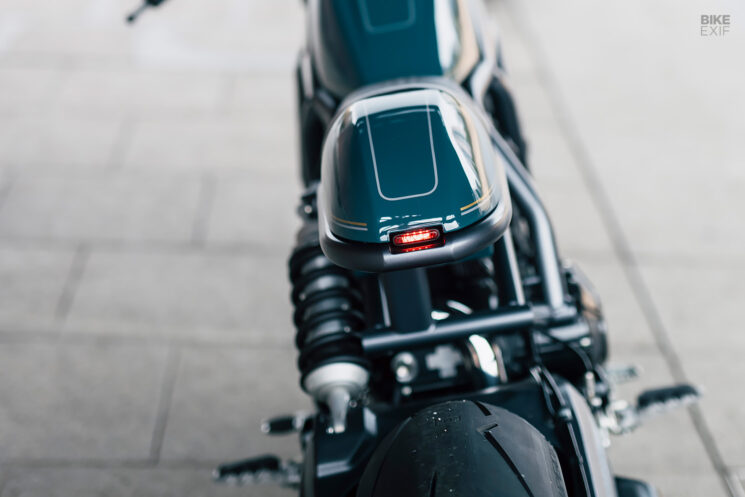The Ducati Scrambler 1100 is not long for this world. Rather than update its aging engine (originally borrowed from the Monster 1100) to meet ever-stricter European emissions regulations, Ducati is dropping it from its portfolio altogether.
The odds were stacked against the Ducati Scrambler 1100 from the get-go. It offers less power than most of its competitors for the same, or more, money. And the fact that it inherited the goofy ‘Scrambler’ moniker from the more established Ducati Scrambler 800 when it barely resembles one, hasn’t helped.
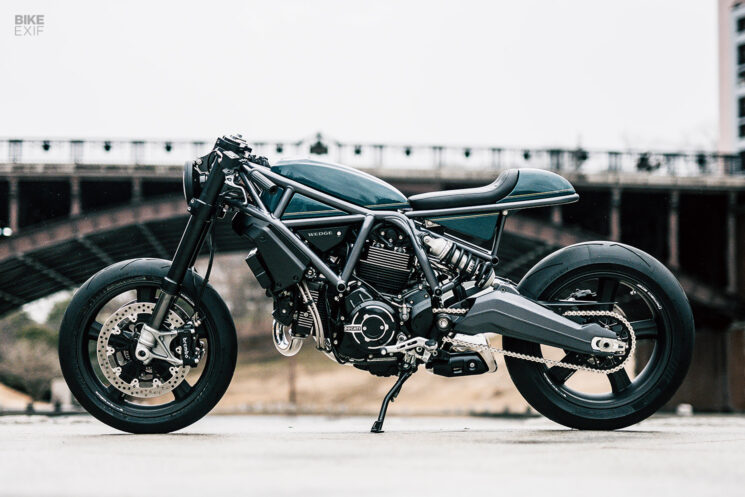
As far as we’re concerned, the Scrambler 1100 got a raw deal. It has a lot going for it in the looks department, its air-cooled mill feels wonderfully retro, and it’s a delight to ride. With better numbers and a smaller price tag, it could have been a hit.
The current model—the Ducati Scrambler 1100 Sport Pro—also boasts Öhlins suspension and Brembo brakes. Combined with its classy trellis frame, it makes it ripe for a neo-retro café racer makeover.
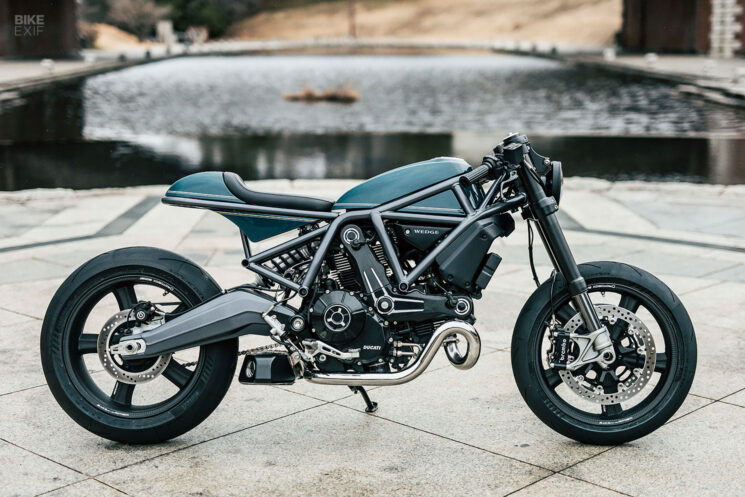
Takashi Nihira thinks so too. When a client requested a liter-plus café racer build from the Japanese custom builder’s workshop, Wedge Motorcycle, Nihira-san gravitated towards the maligned Scrambler.
“The customer wanted a café racer based on the Honda CB1100,” he explains, “but he also owns a European sports car and enjoys sporty driving. So, considering the customer’s tastes, I proposed using a European bike instead of the CB1100, choosing the Ducati Scrambler 1100 Sport Pro as the donor.”

“When I build custom bikes, I always think about what kind of lifestyle the customer has. What kind of clothes does he wear, what kind of cars does he drive, and what does he want to do with the bike? I look at them, listen to them, and formulate an image of the custom bike I want to build.”
“Even if a custom builder builds what he wants to, it is meaningless if it does not fit the owner’s style.”

Working with a 2022-model Scrambler 1100 Sport Pro, Takashi quickly earmarked the parts he wanted to keep and binned everything else. He fell in love with the Ducati’s trellis frame the second the bike was stripped, so his next step was figuring out how to turn it into the centerpiece of the build.
Much of the Scrambler 1100’s frame is covered by its chunky fuel tank, including a twin-spar section that runs up to the steering neck. But Takashi wanted it to be fully exposed—so he built a new fuel tank that sits ‘inside’ the frame instead.
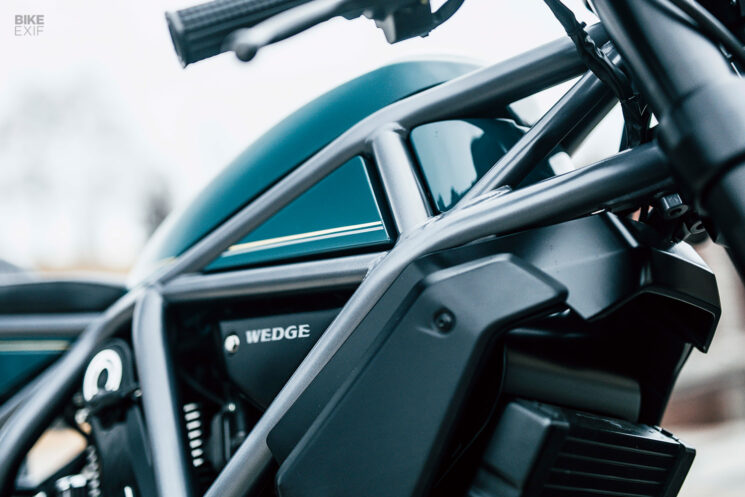
Although the tank appears to be wedged into the frame, it’s not. The main reservoir is wide up top and narrow at the bottom, so that it tucks into the trellis structure. The other bits you see are covers, designed to give the impression of one continuous unit.
Shaping each part to match the angle and curve of the next, while maintaining a uniform gap between each section and the frame, took some doing. “The edges of the side covers were not made by welding straight aluminum plates together, but rather by welding the edges of two rounded aluminum plates together,” Takashi explains. “It was also difficult because the high heat of welding causes distortion, which is difficult to remove.”
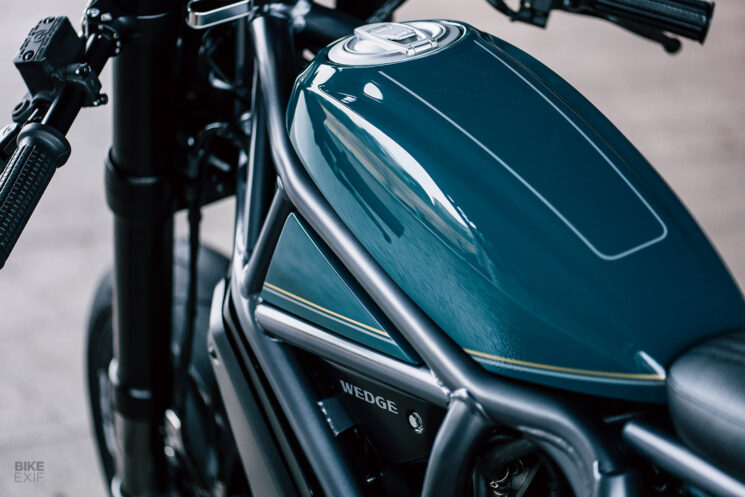
Because of the tight spaces he was working with, Takashi then fabricated a second reservoir that sits below the frame’s main backbone. Painted black to remain inconspicuous, it also hosts the bike’s fuel pump.
The Ducati Scrambler 1100’s bodywork truly is a tour de force. The fuel tank not only utilizes the stock fuel cap but also features a slightly raised center strip, which Takashi deliberately added as a nod to the OEM design. That detail is carried through to the custom-built tail cowl, with a custom-made seat pad sitting in the middle.

An obsessive commitment to geometric harmony is on display all over Wedge’s café racer. Takashi rebuilt the section of the frame that runs underneath the fuel tank, before fabricating an all-new subframe. Set to one side to accommodate the Scrambler 1100’s left-mounted rear shock, the trellised section below the seat mirrors the frame’s front half.
You can trace parallel lines from the steering neck to the swingarm, or from the base of the fuel tank to the tip of the tail. Out back, cutouts in both the tail cowl and frame offer space for a Highsider taillight. Lower down, a triangular electronics tray riffs off the bike’s other angular elements, while sporting an asymmetrical design that integrates seamlessly with both the rear shock and offset subframe.
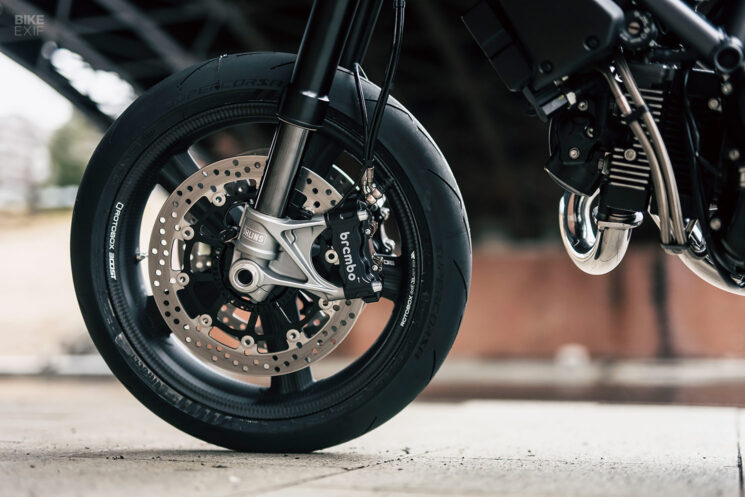
The Scrambler 1100 was also treated to a set of 17” carbon fiber wheels from Rotobox, wrapped in Pirelli Diablo Supercorsa SP V4 rubber. There’s no denying that carbon fiber wheels are a great aesthetic upgrade—but this change was motivated by performance. “The customer didn’t want a café racer with an emphasis on style alone, but wanted to enjoy riding it too,” says Takashi.
To that end, the twin Brembo front brake calipers were upgraded with higher-spec billet items from Brembo’s catalog. The adjustable Öhlins suspension was up to the task, but the signature gold and yellow details were out of sync with the overall vibe. So Takashi had the fork uppers anodized black, the lowers treated to a titanium coating, and the rear shock spring powder-coated black.
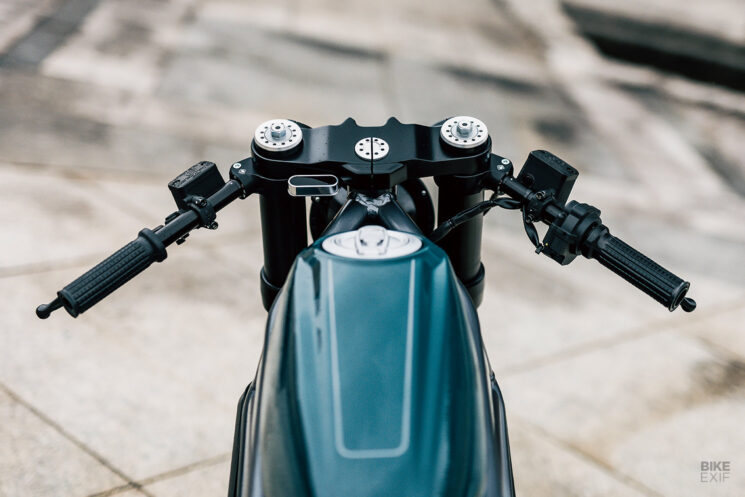
Moving to the cockpit, Takashi cleaned up the top yoke and fitted a set of clip-ons. The ignition barrel was relocated to the left-hand side of the bike, with a custom headlight bracket mounted in its place. A Highsider LED unit lights the way.
The Scrambler 1100 won’t run without its bulky dashboard plugged in, but Takashi wanted to run a tiny Motogadget speedo instead. So he stripped the stock dash, removed the bits that he didn’t need, and stashed the remaining modules under the seat.
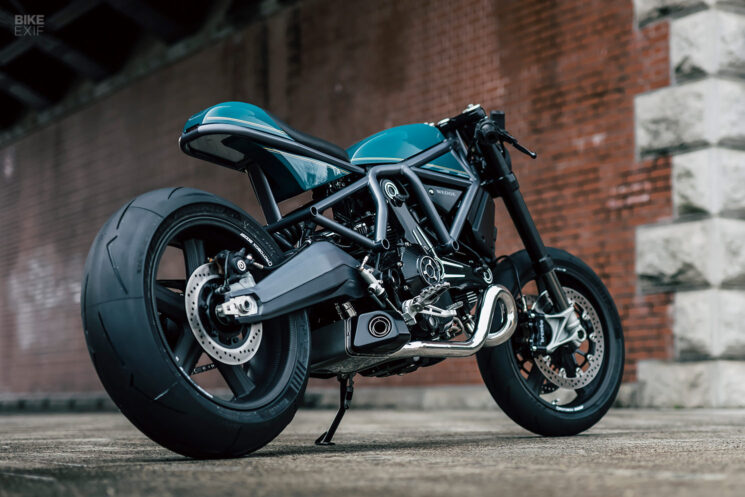
As with all his projects, Takashi handled the Ducati’s paint job himself. A lush teal finish is augmented with tasteful pin-stripes, all of which complement the lines of the trellis frame. And then there’s the exhaust system; a pair of elegant headers terminating in a heavily modified Leo Vince muffler.
The Ducati Scrambler 1100 might be on its way out—but if this masterpiece is anything to go by, it should find new life in the custom scene.
Wedge Motorcycle | Facebook | Instagram | Images by Hiromitsu Yasui | With thanks to Tadashi Kono
